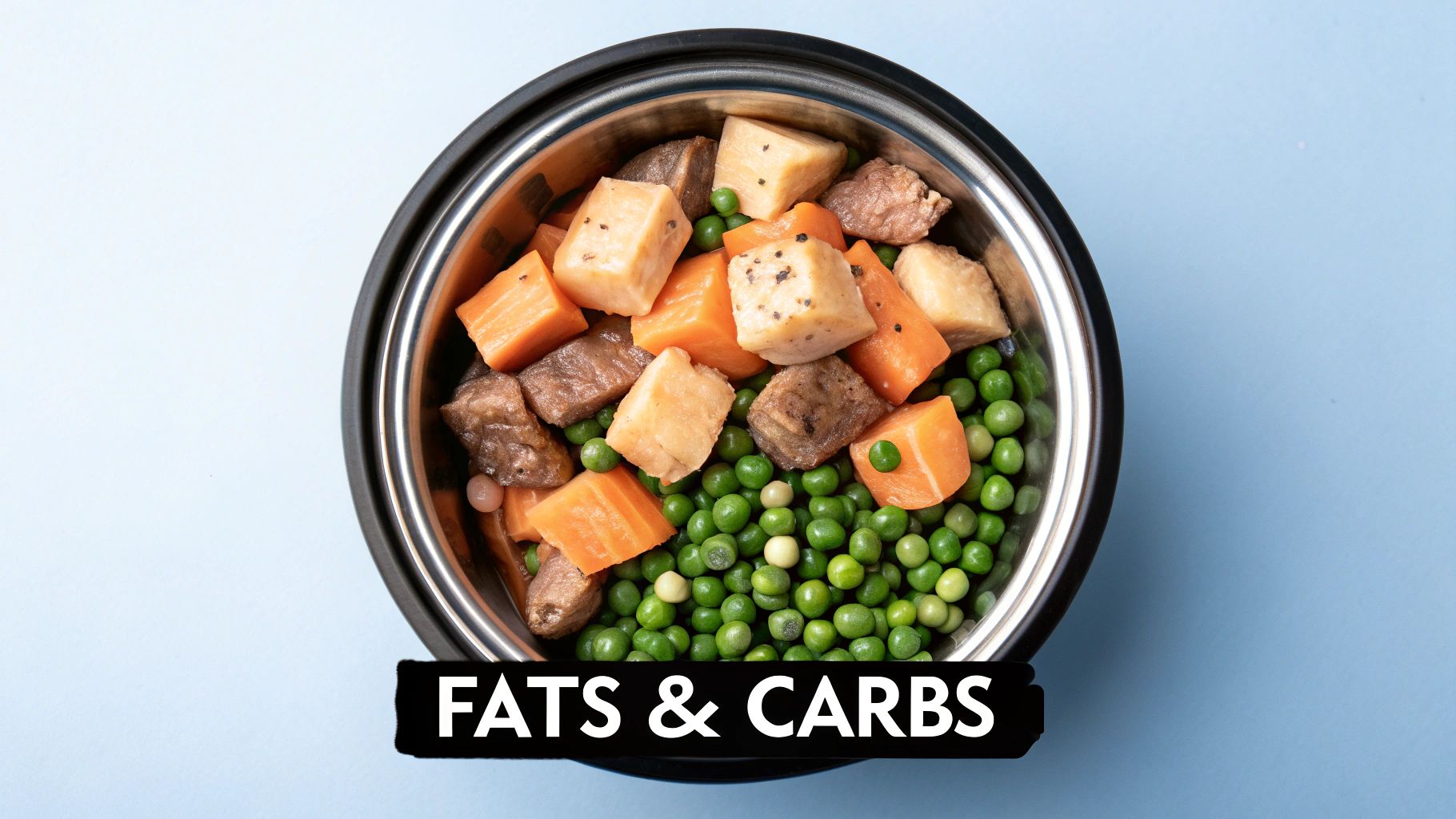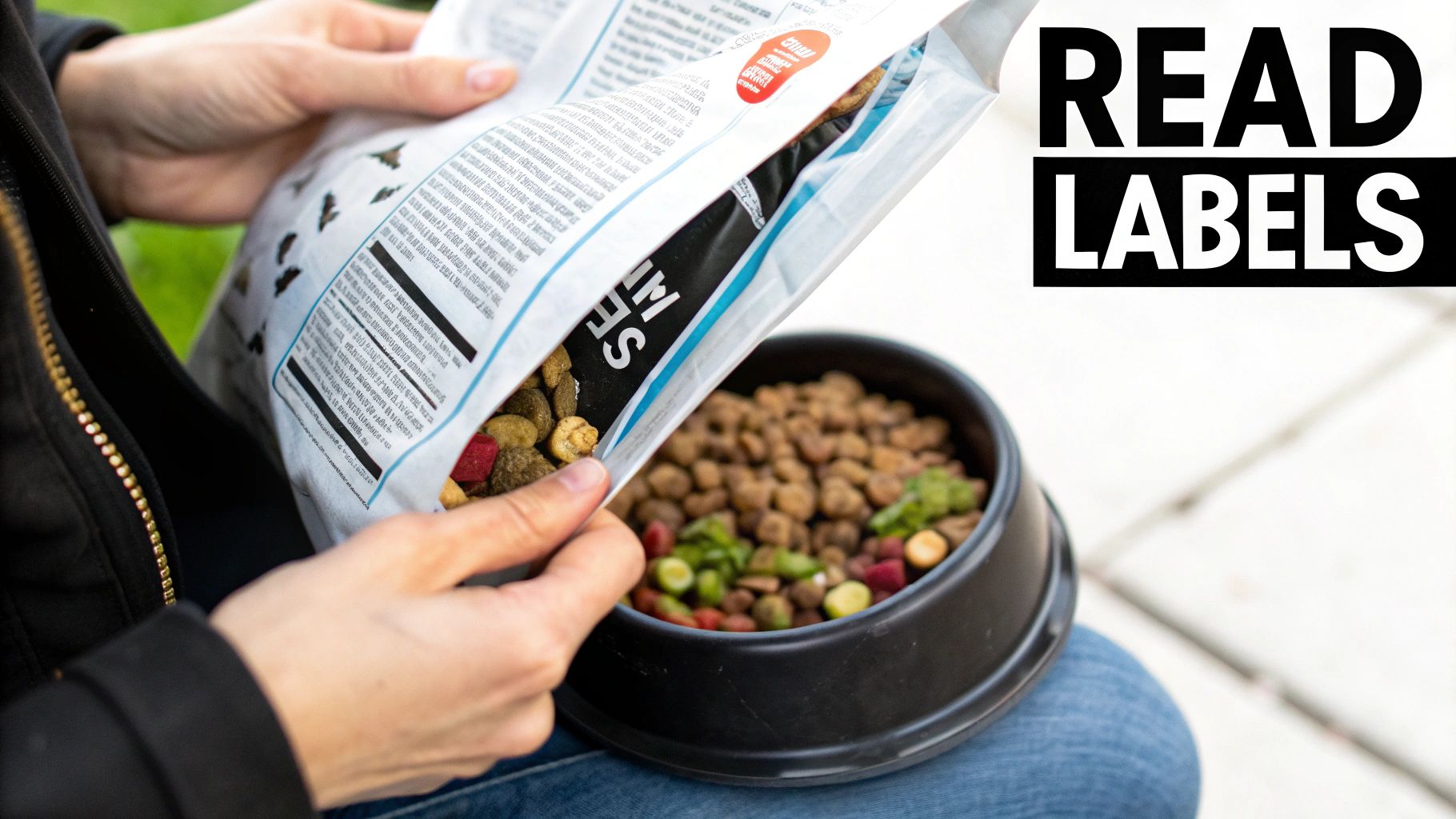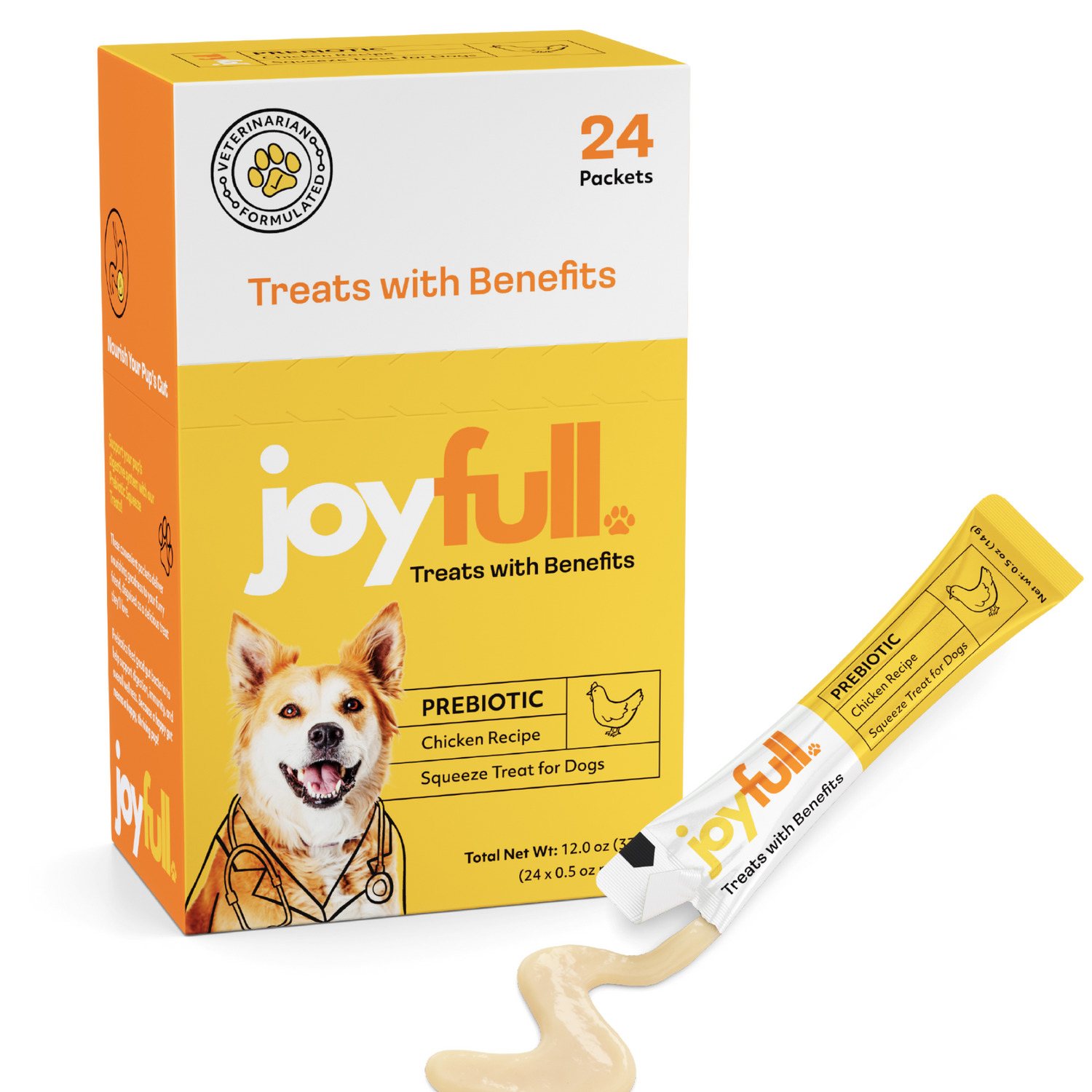
What Are Good Ingredients in Dog Food
So, what actually makes a good dog food? The short answer is a solid foundation of high-quality animal proteins, beneficial fats, and digestible carbohydrates. It's a lot like building a house: protein acts as the sturdy frame, fats are the essential wiring and insulation, and carbs provide the energy to keep the lights on.
The Building Blocks of a Healthy Bowl
Walking down the dog food aisle can feel overwhelming. You’re hit with a wall of colorful bags, all making big promises. But the secret isn't just about what's in the food—it's about how those ingredients work together to support your dog from the inside out. The best way to cut through the noise is to focus on the big three: proteins, fats, and carbohydrates.
Of course, not all ingredients are created equal. This is where a concept called bioavailability comes into play. Think of it as how well your dog's body can actually absorb and use the nutrients in their bowl. A food can look great on paper, packed with protein, but if that protein comes from a low-quality, indigestible source, it’s not doing your dog much good. This is why recognizable, whole-food ingredients are always the gold standard.
Understanding the Nutritional Hierarchy
To make things a little clearer, it helps to see how these core components fit together in a balanced meal. This infographic breaks down the primary building blocks you should be looking for in a healthy dog food formula.

As you can see, a truly balanced diet isn't just about one superstar ingredient. It’s about the synergy between protein for muscle and tissue repair, fats for energy and vital functions, and carbohydrates for accessible fuel.
Over the last ten years, dog owners have become much more savvy, and their demand for better ingredients has completely changed the game. High-quality, animal-derived proteins like chicken and beef are still king because they’re easy for dogs to digest and offer a complete amino acid profile. This isn't just a fleeting trend; the global dog food market is expected to hit a staggering $91.82 billion by 2035, as detailed in this insightful dog food market analysis.
The goal is to get past those mile-long, confusing ingredient lists and focus on nutrient quality. A shorter list of high-quality, recognizable ingredients is almost always better than a long one padded with synthetic additives and cheap fillers.
To help you spot the good stuff at a glance, here’s a quick summary of the best-in-class ingredients to look for on a label.
Quick Guide to Top-Tier Ingredients
| Ingredient Category | Excellent Examples | Key Benefit |
|---|---|---|
| High-Quality Protein | Deboned Chicken, Beef, Lamb, Salmon Meal | Builds and repairs muscle, supports organ function |
| Healthy Fats | Chicken Fat, Salmon Oil, Flaxseed | Provides concentrated energy, promotes healthy skin and coat |
| Digestible Carbs | Sweet Potatoes, Brown Rice, Peas, Oats | Offers steady energy, provides essential fiber for digestion |
| Vitamins & Minerals | Kelp, Blueberries, Carrots, Zinc Proteinate | Supports immune system, vision, and overall cellular health |
This table isn't exhaustive, but it gives you a solid starting point for what a premium ingredient panel should look like.
Embracing this "quality over quantity" mindset is the first real step toward becoming a more confident and informed pet parent. To dig deeper into what you don't want to see on a label, take a look at our guide on finding a quality dog food without fillers. It's all about getting back to basics with a clean, effective diet for your best friend.
Why High-Quality Protein Comes First
When you pick up a bag of dog food and turn it over, the first thing you should look for is the protein source. It's the absolute cornerstone of your dog's health. Protein isn't just about building muscle; it's the fundamental building block for just about everything in their body—from their organs and immune system to their skin and coat.
Think of proteins as long, intricate chains made up of smaller links called amino acids. Imagine them like LEGOs. Your dog needs 22 different types of these amino acid "LEGOs" to build and maintain their body. While they can make 12 of these on their own, the other 10 are called essential amino acids, and they must get them from what they eat.

This is exactly why the type of protein in their food is so crucial. Proteins from animal sources are "complete," meaning they contain all 10 of those essential amino acids in the right ratios. This makes them easy for your dog’s body to absorb and use right away.
Spotting Superior Protein Sources
A quick pro-tip for reading labels: ingredients are listed by weight. So, when you see a specific, high-quality animal protein right at the top of the list, you know it’s the main event in that recipe.
Here are some of the best protein sources you want to see listed first:
- Whole Meats: Look for clear terms like deboned chicken, grass-fed beef, lamb, or turkey. These are premium ingredients that deliver protein alongside natural fats and other nutrients.
- Fish: Ingredients like wild-caught salmon and whitefish are protein powerhouses that also pack a healthy punch of anti-inflammatory omega-3 fatty acids.
- Meat Meals: Don't let the word "meal" scare you. A named meal, like chicken meal or salmon meal, is a fantastic, concentrated source of protein. It's simply the whole meat with the water and fat rendered out, leaving behind a potent, amino-acid-rich ingredient.
A good dog food label should read like a grocery list you can actually understand. If the first ingredient is something clear like "deboned chicken," you're heading in the right direction.
Decoding Vague Protein Terms
On the flip side, some labels get a bit cagey with their language, and that's usually a red flag. Vague, generic terms are often used to hide lower-quality ingredients that just don't offer the same nutritional bang for your buck.
Keep an eye out for these less-than-ideal terms:
- "Meat By-Products": This is a catch-all term for what’s left over. It could include a mix of animal parts, and the lack of specificity means you have no idea what you're really getting.
- "Meat and Bone Meal": Similar to by-products, this is an ambiguous ingredient from rendered animal tissue. It's a far cry from a high-quality, named protein meal like lamb meal.
Honestly, choosing the right protein is the most important decision you can make when picking out your dog's food. By focusing on identifiable, high-quality animal sources, you're making sure they get the essential building blocks they need to live a healthy, vibrant life. For a deeper dive, take a look at our complete guide on high-quality protein for dogs.
Fueling Your Dog with Fats and Carbs
Once you’ve got protein sorted, the next power couple in your dog's bowl is fats and carbohydrates. I know these two can get a bad rap in our own diets, but for dogs, they're absolutely non-negotiable for a healthy, vibrant life. When you get the right kinds, fats and carbs are the dynamic duo that fuels everything from a game of fetch to the microscopic work happening inside every cell.
When it comes to pure energy, healthy fats are a dog's best friend. Think of them as premium, high-octane fuel. Gram for gram, fat delivers more than double the energy of protein or carbs. This is obviously great for active dogs, but the benefits don't stop there.

Fats are also what give your dog that shiny, soft coat and healthy skin. Plus, they’re essential for absorbing important vitamins like A, D, E, and K. That’s why you want to see specific, high-quality fat sources on that ingredient list.
Identifying High-Quality Fats
Not all fats are created equal. Just like with protein, the devil is in the details—or in this case, the name. Vague descriptions like "animal fat" are a red flag. Instead, you want to look for named sources.
Here are a few excellent fat sources you'll find in top-tier dog foods:
- Chicken Fat: Dogs love the taste, and it’s a fantastic, easy-to-digest source of linoleic acid, which is a vital omega-6 fatty acid.
- Salmon Oil: This one is a true superstar. It's packed with omega-3 fatty acids (EPA and DHA) that are famous for boosting brain health, calming inflammation, and giving that coat an incredible sheen.
- Flaxseed: A wonderful plant-based source of another important omega-3, alpha-linolenic acid (ALA).
These aren't just empty calories. Good fats are active players in your dog’s health, supporting their immune system, cognitive function, and so much more.
Healthy fats are the premium fuel that keeps your dog's engine running smoothly. They deliver concentrated energy for zoomies, support brain development for training, and build a shiny coat that reflects their inner health.
The Role of Smart Carbohydrates
Carbs have definitely become a hot-button issue in dog food circles, but they have a real purpose in a well-rounded diet. The trick is telling the good guys (complex carbs) from the not-so-great ones (simple fillers). Quality carbs offer a readily available source of energy and, just as importantly, fiber for smooth digestion.
I like to use a campfire analogy. Simple carbs like corn, wheat, and soy are like tossing newspaper on the fire. You get a quick burst of flame, but it fizzles out fast, leading to energy spikes and crashes. They don't offer much else nutritionally.
On the other hand, complex carbohydrates are like dense, seasoned logs. They burn slowly and steadily, providing sustained energy that lasts all day. These are the carbs you want to see on the label.
Look for beneficial complex carbs like these:
- Sweet Potatoes: Loaded with fiber, vitamins, and minerals.
- Peas: A great source of both fiber and some bonus plant-based protein.
- Brown Rice: A gentle, digestible whole grain that provides consistent fuel.
- Oats: Especially good for their soluble fiber, which can help keep blood sugar levels stable.
By opting for a food with these kinds of good ingredients in dog food, you’re giving your dog the steady-burning fuel they need for a happy, energetic life, without all the empty calories from cheap fillers.
Beyond the Basics with Vitamins and Superfoods
Think of high-quality proteins, fats, and carbs as the foundation of your dog's diet—the walls and roof that provide essential structure. But what turns a basic house into a comfortable, functional home? It’s the details, and in dog food, those details are the micronutrients.
Vitamins, minerals, and functional "superfoods" elevate a good meal to a great one. These small but mighty additions do the heavy lifting behind the scenes, from strengthening the immune system and keeping joints limber to supporting brain health. When you spot ingredients like blueberries, kelp, or probiotics on the label, you're looking at a food designed not just for survival, but for a dog to truly thrive.
This focus on nutrient-packed, functional foods is a huge shift in the pet food world. In fact, over 60% of new dog food products now feature at least one "superfood" like pumpkin or blueberries. That's a massive leap from just 35% a few years ago. This trend shows just how much pet parents now expect from their dog's food, a topic you can explore in more detail through pet food market analysis.
Decoding Functional Ingredients on the Label
It’s easy to write off terms like "superfoods" as nothing more than clever marketing. But the truth is, many of these ingredients offer real, science-backed benefits for your dog. They deliver antioxidants, prebiotics, and other compounds that play a specific, targeted role in your dog's health. Knowing what they do makes you a much smarter shopper.
Here’s a quick look at some of the most powerful functional ingredients you'll find:
-
Antioxidant-Rich Fruits & Veggies: Ingredients like blueberries, cranberries, spinach, and carrots are loaded with antioxidants. These compounds are your dog’s personal security team, neutralizing damaging free radicals that contribute to aging and disease.
-
Probiotics and Prebiotics: A healthy gut is the command center for overall wellness. Probiotics are the "good" bacteria that help with digestion and immunity. Prebiotics, often from sources like chicory root, are the specialized fibers that feed those good bacteria, helping them flourish.
-
Glucosamine and Chondroitin: Sourced from things like shellfish or poultry, these two are the dream team for joint health. They help maintain cartilage, which is especially vital for large breeds, seniors, and very active dogs who put extra wear and tear on their joints.
-
Omega Fatty Acids from Fish Oil: While all fats provide energy, the omega-3s found in sources like salmon oil are different. They have potent anti-inflammatory properties that support everything from a shiny coat and healthy skin to joint comfort and brain function.
Think of these extras as wellness insurance in every scoop. They’re not just fillers; they are purposeful ingredients that contribute to a resilient immune system, a sharp mind, and comfortable mobility throughout your dog’s life.
By choosing a food that strategically includes these powerhouse ingredients, you’re moving beyond simple nutrition. You're taking a proactive approach to your dog's long-term well-being.
How to Read a Dog Food Label Like an Expert
Alright, you know what makes a great dog food ingredient. Now for the real test: finding them on the bag. The dog food label is your window into what's actually fueling your pup, but let's be honest, it can feel like trying to decipher a foreign language. Let’s break it down so you can walk down the pet food aisle with complete confidence.
Today’s pet parents are more like nutritional detectives than ever before, and for good reason. We're all focused on giving our dogs long, healthy lives. In fact, over 60% of dog owners are now actively reading ingredient labels, and more than half are willing to pay at least 20% more for food made with ingredients they can actually recognize. It's a huge shift in the market, which you can read more about in this full pet food market report.
Unpacking the Guaranteed Analysis
Your first stop on the label is always the Guaranteed Analysis box. This is the "at-a-glance" nutritional snapshot, showing the minimum percentages of crude protein and fat, and the maximum percentages of crude fiber and moisture.
Think of it as the basic nutrition facts, but with a catch. It gives you the numbers, but it doesn't tell you anything about the quality of the ingredients providing those numbers. A high protein percentage is fantastic, but it matters a great deal whether that protein comes from real deboned chicken or a mystery mix of "meat by-products."
Here’s a perfect example of what a standard Guaranteed Analysis panel looks like.

This chart gives you the core macronutrient breakdown, which is a great starting point for comparing different foods.
The Ingredient List Tells the Real Story
This is where you put your detective skills to work. Ingredients are listed by weight, starting with the heaviest. That means the first five to seven ingredients are the heart and soul of the recipe, making up the vast majority of what's in the bag.
A simple rule of thumb I always follow: If the first few ingredients aren't a high-quality animal protein and some beneficial carbs you recognize, it’s probably best to put the bag down and keep looking.
You want to see a named animal protein—like "Beef" or "Salmon Meal"—right at the top of the list. After that should come healthy fats and easily digestible carbs, like chicken fat or sweet potatoes. We get into even more detail in our complete guide on how to read dog food labels.
Finally, always scan the end of the list for red flags. These are the fillers and artificial additives you want to steer clear of.
- Artificial Preservatives: Keep an eye out for BHA, BHT, and ethoxyquin.
- Artificial Colors and Flavors: Things like Red 40 are just chemical dyes your dog absolutely doesn't need.
- Vague Meat Terms: Ingredients like “meat meal” or “animal fat” are intentionally ambiguous and often hide low-quality, mystery sources.
Got Questions About Dog Food? We've Got Answers.
Walking down the dog food aisle can feel like a pop quiz you didn't study for. Even when you have a handle on the basics—proteins, fats, carbs—the labels are full of terms that can leave you scratching your head. Let's tackle some of the most common questions head-on so you can feel less like a student and more like an expert.
Our goal here is to cut through the marketing noise and get to what really matters for your dog's health. By clearing up these specific points, you’ll be able to fine-tune your approach and make choices that truly fit your best friend's needs.
Is "Grain-Free" Always the Healthier Choice?
Honestly, not always. While a grain-free diet is a lifesaver for dogs with diagnosed grain allergies or serious sensitivities, it’s not automatically the best option for every dog out there.
Think of it this way: high-quality whole grains like brown rice, oats, and barley are actually fantastic sources of energy, fiber, and important nutrients for most dogs. The conversation shouldn't be about "grains vs. no grains," but rather about the quality of the carbohydrate source. A well-made food that includes whole, healthy grains is often a perfectly sound, and sometimes better, choice.
Bottom line? Unless your vet has specifically pointed you toward a grain-free diet for a medical reason, there's no need to fear healthy grains.
What’s the Real Difference Between "Chicken" and "Chicken Meal"?
This is probably one of the most-asked questions, and the answer comes down to one simple thing: water.
When a label says "chicken," it’s referring to the fresh, whole chicken you’d buy at the grocery store. It's a fantastic, high-quality ingredient, but it also contains a lot of water weight.
Now, "chicken meal" is a bit different. It’s what you get after the chicken has been cooked down in a process called rendering, which removes the water. What’s left is a super-concentrated, dry protein powder. Because all that water is gone, chicken meal packs a much bigger protein punch gram for gram.
You'll often find that the best foods use both. They might list fresh chicken first for its wholesome appeal, then add a high-quality meat meal (like chicken meal, not a vague "meat meal") to really boost the protein content. Both are great ingredients when they come from a good source.
The most important thing to look for is specificity. "Chicken" or "chicken meal" tells you exactly what you're getting. Vague terms like "poultry meal" are a red flag because the source is a mystery.
Does "Human-Grade" Mean It's Better for My Dog?
The term "human-grade" isn't actually a nutritional claim—it’s a manufacturing standard. It simply means the ingredients are legally fit for people to eat and were handled in a facility licensed for human food production. This usually translates to stricter safety and quality control measures than what’s required for standard animal feed.
While it’s often a sign of a premium product, "human-grade" on the bag doesn't automatically make the food nutritionally superior for your dog. The recipe still needs to be properly balanced for a canine's unique dietary needs. So, while it's a nice feature, you should still flip the bag over and check the full ingredient list and guaranteed analysis to make sure it's a complete and appropriate meal.
How Can I Tell if a New Food is Actually Working for My Dog?
The best report card for any dog food is your dog itself. After you've slowly transitioned to a new food over about 7-10 days, keep an eye out for these positive signs:
- Steady, Happy Energy: Your dog has consistent get-up-and-go throughout the day, without weird energy spikes or lethargic slumps.
- A Gleaming Coat: A soft, shiny coat and healthy, flake-free skin are dead giveaways that the food is delivering the right fatty acids and nutrients.
- Happy Tummy: Look for predictable, firm, and easy-to-pass stools.
- Ideal Weight: Your dog should maintain a healthy weight without you having to drastically over- or under-feed them based on the bag's recommendations.
If you're seeing ongoing stomach upset, a dull coat, itchy skin, or low energy, that food probably isn’t the right fit. And when you're just not sure, a quick call to your veterinarian is always the best move.
At Joyfull, we believe that providing your pet with the best starts with clean, high-quality ingredients you can trust. Our formulas are crafted with care and backed by veterinary expertise to ensure every meal supports a happy, healthful life. Explore our commitment to better pet nutrition at https://joyfullpet.com.

